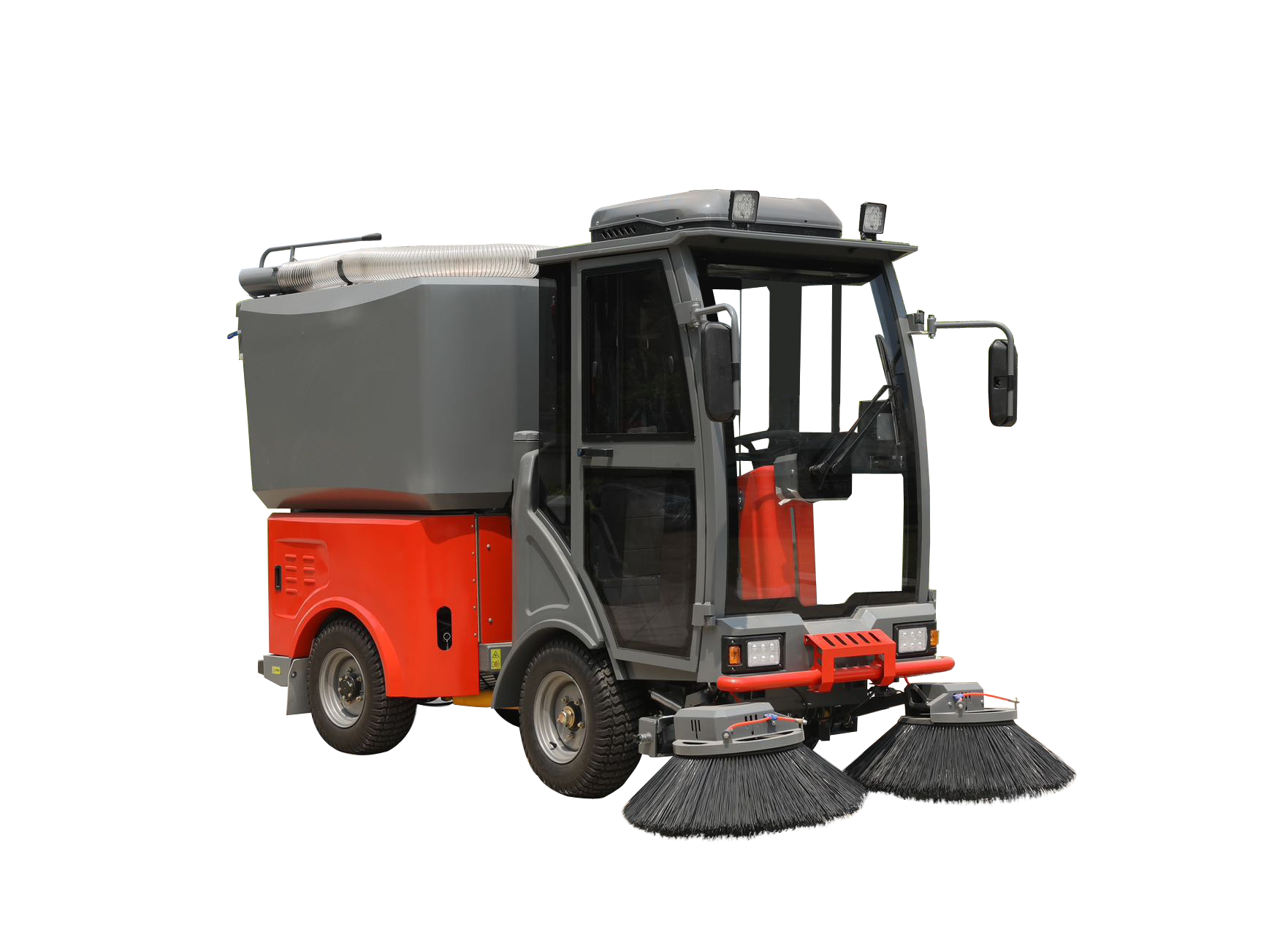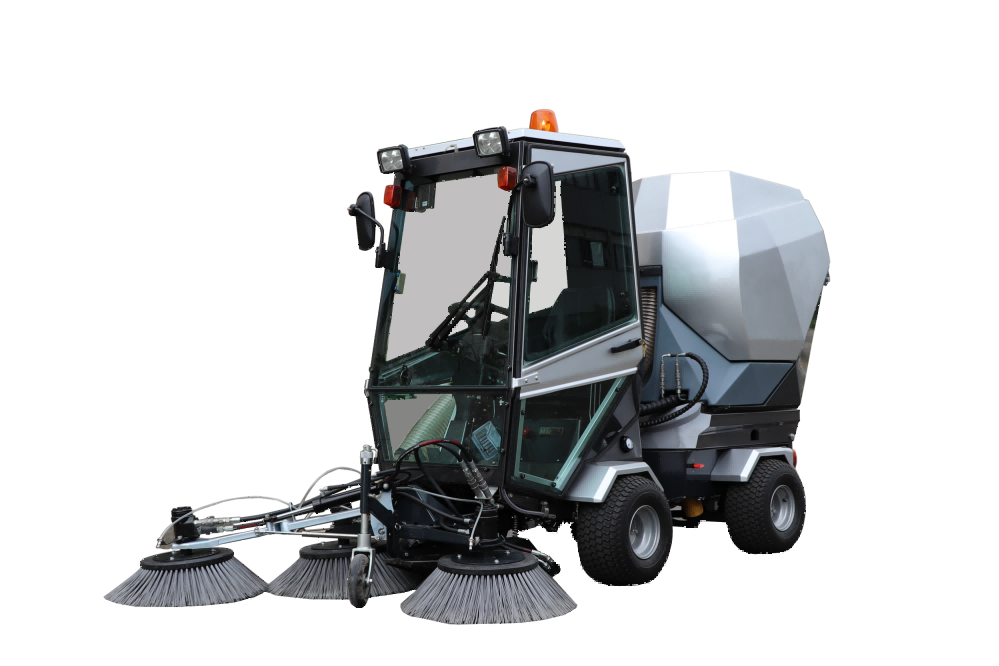Komponen Utama Teknologi Penyapu Jalan Moden
Sistem Berus Putar untuk Penyingkiran Serpihan
Sistem berus putar adalah komponen penting dalam penyapu jalan moden penghapus jalan , menyediakan penyingkiran serpihan yang cekap daripada pelbagai permukaan. Sistem ini menggunakan pelbagai jenis berus, seperti silinder, berus piringan atau berus longkang, direka bentuk untuk prestasi optimum bergantung kepada saiz serpihan dan jenis permukaan. Tetapan boleh laras membolehkan operator mengubah kelajuan dan sudut berus, memaksimumkan keberkesanan penyapu jalan. Sebagai contoh, berus longkang boleh menjangkau kawasan bahu jalan dan tepi untuk mengumpul serpihan secara berkesan.
Prestasi sistem-sistem ini biasanya diukur berdasarkan kecekapan mereka dalam mengutip serpihan. Sistem berkecekapan tinggi mampu mengumpul sehingga 95% serpihan di jalan raya dalam satu laluan sahaja, secara ketara mengurangkan jumlah kotoran yang tertinggal di jalan raya. Kecekapan ini adalah penting kerana ia memastikan jalan-jalan kekal bersih, menyumbang kepada kesihatan awam dengan menghadkan pendedahan kepada zarah berbahaya. Penyelenggaraan berkala pada sistem berus, seperti memantau kehausan berus dan penggantian pada masa yang sesuai, memastikan prestasi yang konsisten dan memperpanjang jangka hayat peralatan. Mengabaikan tugas penyelenggaraan ini boleh membawa kepada kejatuhan keberkesanan pembersihan dan kehausan yang meningkat pada permukaan jalan raya.
Mekanisme Pengumpulan Vakum Dijelaskan
Mekanisme pengumpulan vakum memainkan peranan yang penting dalam menangkap jirim partikulat halus dalam operasi pembersihan jalan. Terdapat pelbagai teknologi vakum, termasuk sistem pemanduan kipas dan udara berulang kembali yang menggunakan prinsip-prinsip berbeza untuk pengumpulan serpihan. Sistem pemanduan kipas bergantung kepada kipas yang berkuasa tinggi untuk mencipta kesan penyedutan, menarik serpihan masuk ke dalam storan, manakala sistem udara berulang kembali menggunakan hembusan udara untuk mengangkat serpihan ke dalam vakum.
Secara relatif, vakum berkipas adalah sangat berkesan dalam memerangkap zarah-zarah kecil, dengan keberkesanan melebihi 99% bagi zarah kurang daripada 0.5 μm. Keberkesanan sebegini adalah penting dalam kawalan pencemaran, kerana satu kajian mendapati sehingga 85% jirim partikel udara berasal daripada habuk jalan raya. Kelajuan dan tekanan vakum memberi kesan ketara terhadap keberkesanan pengumpulan. Sebagai contoh, pengoptimuman kelajuan vakum boleh meningkatkan kadar pengumpulan serpihan dengan mengurangkan aliran udara yang tidak diperlukan dan memaksimumkan daya penyedutan. Keputusan sebenar menunjukkan bahawa apabila kelajuan dan tekanan diuruskan dengan baik, jentera penyapu jalan raya boleh mengurangkan habuk jalan raya sebanyak 76%, menunjukkan kepentingan pelarasan pemboleh ubah-pemboleh ubah ini untuk keberkesanan puncak.
Teknologi Semburan Air untuk Penekanan Habuk
Sistem semburan air memainkan peranan yang penting dalam mengawal pelepasan habuk semasa aktiviti penyapuan jalan. Sistem ini menggunakan rangkaian muncung sembur untuk menyebarkan air di atas permukaan, berkesan menangkap zarah habuk dan menghalangnya daripada terbang ke udara. Jenis dan corak taburan muncung adalah kritikal untuk memastikan liputan yang lengkap dan penekanan habuk yang berkesan.
Teknologi semburan selalunya menggunakan muncung semburan jenis kipas atau kon, yang boleh dilaraskan mengikut sudut dan tekanan semburan yang berbeza berdasarkan keadaan tertentu. Larasan ini membolehkan taburan air yang sekata, memastikan habuk dapat diendapkan secara berkesan di pelbagai jenis medan. Bukti praktikal menyokong kesan positif dari segi persekitaran apabila semburan air digunakan dalam operasi penyapuan jalan. Kajian kes menunjukkan penurunan ketara pada zarah habuk di udara, menekankan kelebihan teknologi ini dari segi alam sekitar serta menyokong matlamat perlindungan ekosistem dengan mencegah pencemaran habuk terhadap udara dan sumber air.
Hopper Penyimpanan Berkenderaan dan Pengurusan Sisa
Hopper penyimpanan pada jentera penyapu jalan merupakan komponen penting untuk pengurusan sisa pepejal yang berkesan. Hopper ini hadir dalam pelbagai saiz dan konfigurasi, mulai daripada hopper kecil yang padat hingga kapasiti yang lebih besar direka untuk tugas pembersihan yang lebih luas. Pemilihan saiz hopper secara langsung mempengaruhi kapasiti sisa pepejal jentera penyapu jalan serta keberkesanannya dalam menguruskan serpihan yang dikumpulkan.

Menganalisis keperluan kapasiti sisa pepejal adalah kritikal untuk mengoptimumkan operasi jentera penyapu. Hopper yang lebih besar mengurangkan kekerapan pembuangan sisa, meningkatkan kecekapan operasi dan membenarkan jeda pembersihan yang lebih panjang. Pembuangan sisa yang tepat pada masanya juga adalah utama untuk mengekalkan kebersihan jalan raya serta mencegah pencemaran sekunder akibat penimbunan serpihan. Pengurusan sisa pepejal yang buruk boleh menyebabkan limpahan, mengganggu prestasi jentera penyapu jalan dan seterusnya menjejaskan kebersihan bandar. Jadual pembuangan sisa pepejal yang berkala mengoptimumkan penggunaan hopper penyimpanan dan memastikan jentera penyapu jalan terus memberi manfaat kesihatan dan persekitaran yang sepatutnya.
Penyapu Mekanikal Berus: Kereta Sorong Tradisional
Penyapu jalan berus mekanikal telah lama menjadi tulang belakang teknologi pembersihan jalan, dikenali dengan reka bentuk yang kukuh dan kesederhanaan mekanikal. Penyapu jalan ini menggunakan berus bulu yang tahan lasak untuk secara berkesan mengumpul sisa dari jalan raya, menjadikannya sangat berkesan untuk operasi pembersihan berskala besar. Ternyata, mesin-mesin ini merupakan perkakas biasa di kawasan bandar di mana penyelenggaraan berkala adalah perlu untuk memastikan jalan raya bebas daripada sisa besar seperti daun dan batu.
Walaupun digunakan secara meluas, penyapu jalan berus mekanikal mempunyai beberapa kelemahan. Ia berfungsi paling baik pada permukaan yang rata dan mungkin kurang berkesan terhadap bahan partikel halus. Bagaimanapun, kosnya yang berpatutan dan ketahanannya menjadikannya pilihan popular bagi pihak berkuasa tempatan yang ingin menguruskan bajet dengan lebih efisien. Walaupun statistik penggunaan dan keberkesanannya boleh berbeza-beza, ia tetap menjadi pilihan utama bagi ramai bandar di seluruh dunia.
Sistem Udara Menjana Semula untuk Partikel Halus
Pembersih jalan udara regeneratif mewakili satu peningkatan besar dalam teknologi pembersihan jalan, yang direka khas untuk menangkap partikel halus. Sistem ini beroperasi dengan menggunakan aliran udara kelajuan tinggi untuk melonggarkan kotoran dan serpihan, sebelum menyedutnya ke dalam takungan pada kenderaan tersebut. Ciri menariknya ialah keupayaan mereka untuk menstruktur semula udara yang digunakan dalam proses pembersihan, seterusnya menyumbang kepada prestasi persekitaran yang lebih baik.
Keberkesanan pembersih jalan udara regeneratif dalam mengurangkan pencemaran disokong oleh pelbagai kajian yang menunjukkan keupayaan mereka dalam menangkap jirim partikulat berbanding pembersih jalan tradisional. Selain itu, sistem ini semakin mematuhi piawaian persekitaran yang ketat, memandangkan ia dapat mengurangkan jumlah partikel udara yang terlepas semasa operasi pembersihan. Penggunaannya selari dengan polisi persekitaran semasa yang bertujuan meminimumkan pencemaran bandar.
Pembersih Vakum Tulen dalam Persekitaran Bandar
Pembersih jalan vakum tulen sangat menguntungkan di kawasan bandar yang padat penduduknya disebabkan oleh keupayaan penyedutan yang kuat dan kecekapan mesin ini. Reka bentuk mesin ini membolehkannya berfungsi dengan cemerlang di jalan-jalan yang sibuk, dapat membersihkan habuk halus dan serpihan besar dengan cepat, menjadikannya sesuai untuk bandar-bandar dengan trafik tinggi dan banyak kekacauan.
Contoh daripada pusat-pusat bandar menunjukkan keberkesanan mesin ini dalam mengekalkan kebersihan walaupun dalam persekitaran yang sibuk. Sebagai contoh, penggunaannya di bandar-bandar seperti New York City dan London telah menunjukkan peningkatan ketara dari segi kebersihan jalan. Walau bagaimanapun, keupayaan ini turut membawa keperluan penyelenggaraan yang lebih tinggi serta kos berkaitan. Kos ini boleh merangkumi penggantian penapis secara kerap dan penyelenggaraan motor secara berkala, menjadikan kos operasi sebagai pertimbangan bagi pasukan pengurusan bandar.
Inovasi Hibrid Mekanikal-Vakum
Pembersih jalan hibrid mekanikal-vakum menggabungkan kelebihan kedua-dua teknologi, iaitu teknologi berus mekanikal dan kuasa vakum tulen. Inovasi ini menawarkan kepelbagaian dan prestasi yang tiada tandingan dalam pelbagai aplikasi pembersihan jalan. Reka bentuknya membolehkan penggunaan berus berputar dan hisapan vakum secara serentak, mengoptimumkan usaha pengumpulan serpihan.
Trend pasaran menunjukkan peningkatan permintaan terhadap pembersih jalan hibrid, dengan semakin banyak kawasan mengadopsi teknologi ini sebagai solusi pembersihan jalan yang menyeluruh. Dengan menggabungkan teknologi mekanikal dan vakum, pembersih hibrid ini mewakili inovasi baru dalam teknologi pembersihan jalan yang mampu menangani pelbagai keperluan pembersihan bandar. Kenaikan populariti ini menunjukkan peralihan ke arah penyelesaian penyelenggaraan jalan yang lebih efisien dan fleksibel.
Kesan Ke atas Alam Sekitar dan Kawalan Pencemaran
Strategi Pengurangan Habuk PM2.5/PM10
Memahami kepentingan PM2.5 dan PM10 sebagai penunjuk kualiti udara adalah sangat penting dalam usaha kawalan pencemaran, memandangkan zarah-zarah ini telah ditentukan oleh organisasi kesihatan sebagai ancaman serius kepada kesihatan. Strategi penyapuan jalan yang berkesan, seperti menggunakan teknologi terkini seperti sistem udara regeneratif, memainkan peranan yang penting dalam mengawal pelepasan habuk. Pembersih jalan ini direka bentuk untuk menangkap zarah halus tersebut, seterusnya membawa peningkatan ketara pada kualiti udara selepas penyapuan. Sebagai contoh, kajian telah menunjukkan pengurangan yang ketara dalam zarah habuk di persekitaran bandar selepas aktiviti penyapuan jalan yang berkala, menekankan keberkesanan strategi ini dalam mengurangkan pencemaran udara.
Perlindungan Kualiti Air Larian Storm
Pembersihan jalan raya memainkan peranan yang penting dalam melindungi kualiti larian air hujan. Menurut kesusasteraan sains persekitaran, penyapu jalan berkesan dalam menangkap dan mengeluarkan bahan pencemar seperti minyak, logam, dan serpihan yang boleh mencemarkan air larian. Usaha sama antara pihak berkuasa tempatan dan agensi-agensi persekitaran telah menghasilkan statistik yang menunjukkan penurunan ketara dalam bahan pencemaran di dalam air hujan. Sebagai contoh, bandar-bandar yang melaksanakan penyapuan jalan secara berkala telah menyaksikan penurunan yang ketara dalam jumlah bahan pencemaran yang memasuki badan air tempatan, ini menegaskan kepentingan amalan ini dalam perlindungan alam sekitar.
Penyapu Elektrik & Hidrid: Pengurangan Emisi
Teknologi penyapu jalan elektrik dan hibrid kini memperkenalkan inovasi dalam pengurangan pelepasan bagi operasi pihak berkuasa tempatan. Penyapu jalan jenis ini memberi kelebihan keberlanjutan yang besar dengan pengurangan jejak karbon yang ketara berbanding jentera berkuasa diesel. Metrik keberlanjutan menunjukkan keberkesanan mereka, di mana penyapu jalan elektrik terus menurunkan tahap pelepasan di bandar-bandar yang telah memperkenalkannya. Ke arah masa depan, trend menunjukkan peralihan semakin meningkat kepada teknologi ini, dipacu oleh insentif yang bertujuan mempromosikan pembangunan bandar berkelanjutan serta mengurangkan pelepasan gas rumah hijau oleh pihak berkuasa tempatan.
Integrasi Teknologi Pintar
Perisian Pengoptimuman Penghalaan GPS
Pengintegrasian teknologi GPS ke dalam operasi jentera penyapu jalan memberi peningkatan ketara kepada kecekapan pengurusan laluan. Dengan penjejakan lokasi secara masa nyata dan data, sistem GPS memastikan jentera penyapu jalan mengikuti laluan yang paling optimum, seterusnya mengurangkan penggunaan bahan api dan meningkatkan produktiviti keseluruhan. Statistik menunjukkan bandar-bandar yang menggunakan pengoptimuman penghalaan GPS mengalami peningkatan ketara dari segi masa tindak balas. Sebagai contoh, satu kajian di Bandar New York mendapati peningkatan sebanyak 20% dalam kecekapan liputan jalan, membawa kepada penjimatan kos operasi yang besar. Bandar-bandar seperti San Francisco dan Chicago telah berjaya melaksanakan penyelesaian GPS, menampilkan keunggulan teknologi ini dalam meningkatkan prestasi armada.
Telematik untuk Pengurusan Armada
Sistem telematik memainkan peranan yang sangat penting dalam memodenkan pengurusan armada dalam operasi pembersihan jalan raya. Sistem-sistem ini menyediakan maklumat berdasarkan data mengenai penggunaan kenderaan, prestasi enjin, dan keperluan penyelenggaraan, membolehkan tindakan segera diambil serta meningkatkan keberkesanan operasi. Dengan menggunakan telematik, pihak berkuasa tempatan boleh meningkatkan kebolehpercayaan armada sambil mengurangkan kejadian gangguan tidak dirancang. Analisis faedah-kos oleh pihak berkuasa pengangkutan utama menunjukkan penurunan sehingga 15% dalam kos penyelenggaraan, membuktikan betapa signifikannya kesan telematik dalam industri ini. Pengintegrasian telematik ke dalam teknologi jentera penyapu jalan merupakan satu langkah progresif ke arah amalan kebersihan bandar yang lebih cerdik dan cekap.
Pengesan Serpihan Berbantuan Kamera
Operasi pembersihan jalan moden semakin bergantung kepada sistem kamera untuk meningkatkan ketepatan pengesanan serpihan. Teknologi kamera terkini ini membantu mengenal pasti kawasan dengan penambahan serpihan yang lebih tinggi, membolehkan pembersihan secara sasaran tanpa pembaziran sumber. Metrik prestasi menunjukkan peningkatan yang ketara dalam pengesanan serpihan, dengan sesetengah sistem mencapai peningkatan ketepatan sehingga 30% berbanding kaedah tradisional. Akibatnya, bandar-bandar yang menggunakan teknologi bantuan kamera melaporkan penjimatan kos yang besar dalam pengurusan serpihan dengan memberi tumpuan usaha pada kawasan yang benar-benar memerlukan, seterusnya membuka jalan untuk proses pembersihan jalan yang lebih cekap dan menyeluruh.
Pemberitahuan Penyelenggaraan Berteraskan IoT
Aplikasi teknologi IoT dalam penyelenggaraan jentera penyapu jalan merupakan satu kemajuan bermakna dalam pengurusan armada bandar. Sistem berasaskan IoT menyediakan amaran segera berkenaan keperluan penyelenggaraan, seterusnya mengurangkan risiko kegagalan peralatan dan memanjangkan jangka hayat jentera. Statistik menunjukkan integrasi teknologi IoT mampu mengurangkan kos penyelenggaraan sehingga 20% manakala meningkatkan jangka masa operasi secara ketara. Ke arah masa depan, integrasi berterusan IoT dalam perkhidmatan penyelenggaraan bandar akan membawa kecekapan yang lebih tinggi serta peningkatan masa operasi, menandakan era baharu dalam pembersihan jalan secara pintar.
Pertimbangan Operasi dan Penyelenggaraan
Penyesuaian Permukaan untuk Jenis Jalan Berbeza
Menyesuaikan teknik penyapuan mengikut pelbagai jenis jalan adalah penting untuk kebersihan dan penyelenggaraan yang berkesan. Permukaan yang berbeza, dari permaidani licin hingga jalan yang lebih kasar, memerlukan jenis berus dan sistem yang tertentu. Sebagai contoh, permukaan keras mungkin memerlukan berus yang kukuh untuk pembersihan yang menyeluruh, manakala permukaan lembut boleh mendapat faedah daripada pendekatan yang lebih lembut bagi mengelakkan kerosakan. Dengan menyesuaikan kaedah pembersihan mengikut jenis jalan tertentu, bandar-bandar boleh meningkatkan kebersihan jalan dan meminimumkan kehausan pada permukaan. Kisah kejayaan daripada pihak berkuasa tempatan yang telah melaksanakan pendekatan yang disesuaikan ini menegaskan kegunaan teknik yang diadaptasikan untuk persekitaran yang berbeza, menghasilkan jalan yang lebih bersih dan selamat.
Bahan Api vs. Elektrik: Analisis Kos Operasi
Menganalisis kos operasi adalah penting apabila membuat keputusan antara jentera penyapu jalan bermotor dan elektrik. Model bermotor biasanya mempunyai kos bahan api dan penyelenggaraan yang lebih tinggi disebabkan oleh kekompleksan enjin. Sebaliknya, jentera penyapu jalan elektrik, walaupun pada mulanya lebih mahal, menawarkan penjimatan kos dari segi penyelenggaraan dan penggunaan tenaga. Data menunjukkan penjimatan yang ketara dalam kos operasi dari masa ke semasa dengan model elektrik. Pakar meramalkan bahawa faedah kewangan beralih kepada jentera penyapu jalan elektrik akan meningkat apabila teknologi berkembang dan harga bateri menurun, menjadikan jentera penyapu jalan elektrik sebagai pelaburan jangka panjang yang berdaya maju secara kewangan bagi pihak berkuasa tempatan yang bertujuan untuk mengoptimumkan ekonomi pembersihan jalan.
Cabaran Penyesuaian Musim Sejuk di Iklim Sejuk
Operasi pembersihan jalan raya menghadapi cabaran unik di kawasan beriklim sejuk, terutamanya semasa kitaran beku dan cair. Amalan penyediaan untuk musim sejuk amat penting untuk mengekalkan keberkesanan operasi dalam keadaan sedemikian. Amalan terbaik yang disyorkan termasuk penggunaan sistem antibeku, komponen berkemahan, dan pemeriksaan penyelenggaraan secara berkala bagi mengelakkan pembekuan pada bahagian mekanikal. Statistik menunjukkan bahawa cuaca boleh memberi kesan besar kepada jadual dan keberkesanan pembersihan jalan raya, menjadikan persediaan proaktif untuk musim sejuk sebagai perkara yang sangat penting. Penyesuaian terhadap cabaran cuaca sejuk ini memastikan jentera pembersih jalan kekal boleh dipercayai dan efisien, walaupun dalam keadaan sukar, seterusnya mengurangkan masa henti dan mengekalkan tahap kebersihan pada bulan-bulan musim sejuk.
Trend Masa Depan dalam Teknologi Pembersihan Jalan Raya
Pembangunan Kenderaan Menyapu Secara Autonomous
Pembangunan penyapu jalan autonomik mewakili satu lonjakan besar ke hadapan dalam infrastruktur bandar pintar. Sepanjang beberapa tahun kebelakangan ini, kita telah menyaksikan kemajuan yang ketara dengan keajaiban teknologi autonomik ini, menjanjikan peningkatan kecekapan dalam persekitaran bandar. Data menunjukkan bahawa penyapu jalan pemanduan sendiri ini meningkatkan keselamatan secara ketara dan mengurangkan kos operasi, berkat keupayaannya beroperasi tanpa campur tangan manusia. Pemimpin industri meramalkan bahawa apabila teknologi berkembang maju, kita boleh menjangkakan landskap di mana penyapu jalan autonomik ini memainkan peranan kritikal dalam mengekalkan kebersihan bandar, membentuk masa depan perkhidmatan kesihatan awam.
Pemetaan Pencemaran Berkuasa AI
Pemetaan pencemaran berasaskan AI sedang merevolusikan cara kita mengenal pasti dan menangani keperluan pembersihan jalan. Teknologi ini menggunakan algoritma canggih untuk mengesan dan memetakan kawasan panas pencemaran dengan berkesan, membolehkan operasi pembersihan yang lebih tepat sasaran. Kajian kes menunjukkan bahawa bandar-bandar yang menggunakan teknologi AI telah mencapai peningkatan kecekapan dalam pembersihan jalan, seterusnya menjadikan persekitaran lebih bersih. Potensi teknologi ini merangkumi bukan sahaja peningkatan operasi, malah turut boleh mempengaruhi pembuatan dasar dan perancangan strategik untuk kebersihan bandar, memastikan pengagihan sumber yang lebih baik serta menetapkan piawaian baharu bagi tahap kesihatan awam.
Inovasi Kawalan Habuk Tanpa Air
Inovasi dalam teknologi kawalan habuk tanpa air menawarkan penyelesaian yang berjanji kepada cabaran penyapu jalan tradisional, terutamanya berkenaan pelepasan habuk. Dengan kesedaran alam sekitar yang semakin meningkat, inovasi ini direka bentuk untuk meminimumkan kesan terhadap alam sekitar sambil mengekalkan keberkesanan pembersihan jalan. Bukti daripada kajian saintifik dan aplikasi di dunia sebenar menunjukkan keberkesanan sistem tanpa air dalam mengawal habuk tanpa bergantung kepada sumber air. Apabila peraturan alam sekitar menjadi lebih ketat dan kebimbangan berkenaan pemuliharaan air meningkat, penggunaan sistem sedemikian dijangka meningkat, memandu industri pembersihan jalan ke arah amalan yang lebih mampan dan mesra alam.
Soalan Lazim
Apakah komponen utama penyapu jalan moden?
Penyapu jalan moden terdiri daripada sistem berus berputar, mekanisme pengumpulan vakum, teknologi semburan air, dan hopper penyimpanan untuk keberkesanan pembuangan serpihan dan habuk.
Bagaimanakah mekanisme pengumpulan vakum berfungsi dalam penyapu jalan?
Mekanisme pengumpulan vakum dalam penyapu jalan menggunakan kipas atau sistem udara untuk menghasilkan penghisapan, menangkap jirim partikulat halus dari permukaan jalan.
Mengapa teknologi semburan air penting dalam operasi penyapuan jalan?
Teknologi semburan air adalah penting untuk meminimumkan habuk, mencegah zarah habuk daripada terbang ke udara dan menyumbang kepada pencemaran udara semasa operasi penyapuan.
Apakah kemajuan yang wujud dalam penyapu jalan elektrik?
Penyapu jalan elektrik menawarkan faedah pengurangan pelepasan dan keberlanjutan, dengan trend yang menunjukkan peralihan ke model elektrik dan hibrid untuk mengurangkan kesan karbon.
Jadual Kandungan
- Komponen Utama Teknologi Penyapu Jalan Moden
- Penyapu Mekanikal Berus: Kereta Sorong Tradisional
- Sistem Udara Menjana Semula untuk Partikel Halus
- Pembersih Vakum Tulen dalam Persekitaran Bandar
- Inovasi Hibrid Mekanikal-Vakum
- Kesan Ke atas Alam Sekitar dan Kawalan Pencemaran
- Integrasi Teknologi Pintar
- Pertimbangan Operasi dan Penyelenggaraan
- Trend Masa Depan dalam Teknologi Pembersihan Jalan Raya
- Soalan Lazim
 EN
EN
 AR
AR
 FR
FR
 HI
HI
 JA
JA
 KO
KO
 PT
PT
 RU
RU
 ES
ES
 IW
IW
 VI
VI
 TH
TH
 MS
MS

